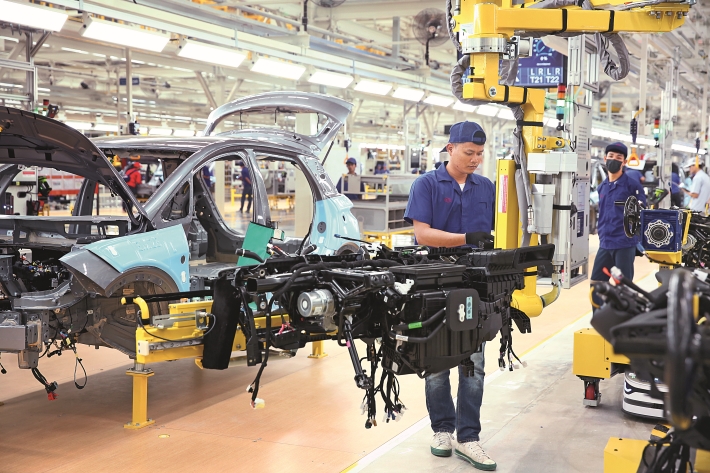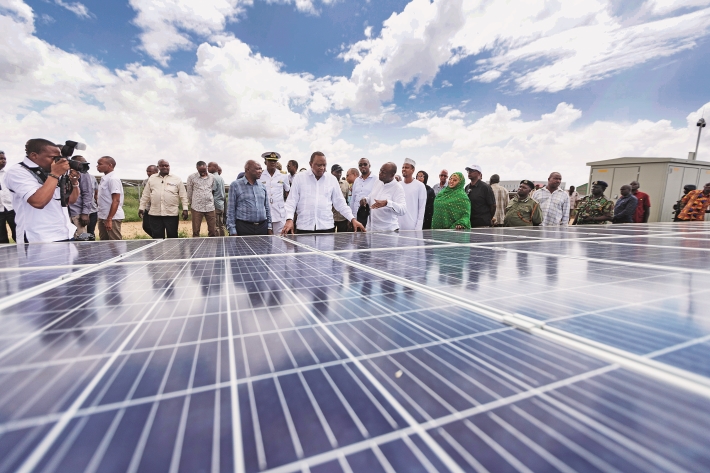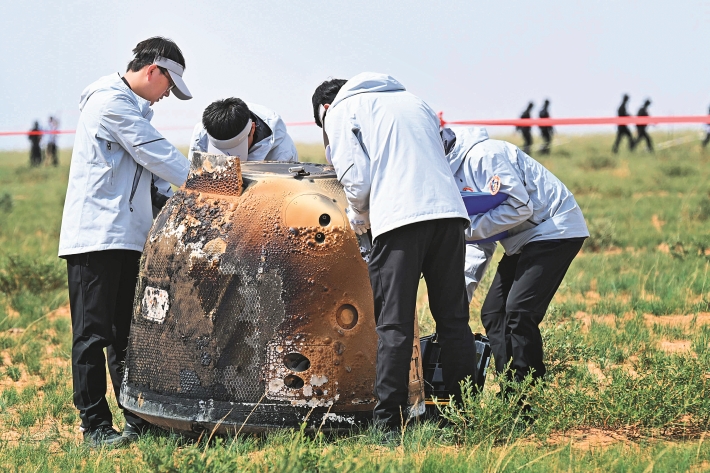|
||||||||||
| Home Top News Economy/Tech Culture/Sports China in Foreign Eyes Green Development Videos Intangible Cultural Heritages |
|
||||||||||
| Home Top News Economy/Tech Culture/Sports China in Foreign Eyes Green Development Videos Intangible Cultural Heritages |
| ChinAfrica |
| Transformed by Technology |
| China is striving to meet global challenges by promoting international cooperation in sci-tech innovation |
| | VOL. 16 August 2024 ·2024-07-24 |

Workers at the BYD factory, a Chinese manufacturer of NEVs, in Rayong Province, Thailand, on 4 July (XINHUA)
In recent years, China has made remarkable technological progress in a number of areas. Given this progress, it is crucial to rapidly transform technological results into productivity gains.
How can technological innovation drive industrial innovation? What is the impact of Chinese technological and industrial innovation on the global economy? Chinese experts share their opinions on these questions.
Technological innovation in the service of industrial innovation
Tian Jietang
Director, Industrial Economics Department, Development Research Centre of the State Council
New technological revolution and industrial transformation are currently taking place, characterised by the continuous development of digital technology, biotechnology, energy and environment technology and artificial intelligence (AI). The wide use of these technologies in various sectors promotes rapid industrial development. Without technological innovation, there will be no high-quality industrial change.
Firstly, it is important to invest more in research and development (R&D) to promote innovation in high value-added industrial chains. By improving workers’ skills through education and training, we can shift the industrial structure from low-end to high-end. To increase competitiveness, we need to keep high-tech segments in the country while attracting more foreign companies to invest and set up in China with an innovation-friendly environment.
Secondly, it is also advisable to strengthen emerging strategic industries. In line with the momentum of new technologies and industries, more and more technologies are expected to be commercialised on a large scale. In 2022, the added value of industries such as advanced equipment and new energy vehicles (NEVs) accounted for more than 13 percent of China’s GDP. Annual production of industrial robots reached 443,000 units, accounting for more than 50 percent of the world’s newly installed capacity. Key components for clean energy generation equipment, such as photovoltaic panels and wind generators, accounted for 70 percent of the global market share. China continued to be the global leader in NEVs with annual sales of more than 6.8 million units. These new industries are becoming an important driver of industrial transformation and socioeconomic development.
Finally, we need to accelerate the transformation and modernisation of traditional industries. To achieve this, four aspects are necessary: establishing a standardisation system covering R&D, promotion, product inspection and control, and law enforcement; accelerating the digital transformation of the manufacturing industry by using technologies such as the Internet, big data, cloud computing, metaverse and blockchain in all phases of design, production and management; piloting large-scale AI models in different sectors to train specific segments in a more targeted way; and developing green manufacturing to build more green factories, parks and data centres.
New tech breakthroughs needed for productivity gains
Luo Liping
Director, Research Institute for Regional Economy and Ecological Development, Hunan Academy of Social Sciences
Deep integration between technological innovation and industrial innovation is essential if research results are to be transformed into real productivity.
It is imperative that we ourselves make important and fundamental technological breakthroughs to support industrial innovation. Given the many technological “bottlenecks” in industrial development, especially in complex large-scale equipment, it is necessary to create a new science and technology system at the national level. The China Railway Construction Heavy Industry Corp. (CRCHI) tunnel boring machines (TBM) are an example of a national R&D plan. In August 2002, then Ministry of Science and Technology officially launched the programme, providing funding, training and basic knowledge. This has provided the company with a robust foundation for the commercial application of its technology and a competitive edge in the market.
It is essential to reinforce the central role of business in innovation and to establish an innovation alliance connecting upstream and downstream partners. Technological and industrial innovation are integrated in two ways. The first is coordinated innovation across the production, research and application sectors. In 2012, CRCHI, as the integrator responsible for overall design and final assembly, collaborated with suppliers and research institutes upstream to achieve technological breakthroughs and with construction units downstream to obtain feedback. This resulted in the formation of a closed-loop innovation alliance. In less than three years, China’s first full-section TBM for hard rock was successfully produced. Conversely, we must actively encourage the growth of R&D companies that collaborate with universities and research institutes to develop new ideas, and then work with manufacturing companies to bring these ideas to fruition.

Then Kenyan President Uhuru Kenyatta (centre) attends the commissioning ceremony of the Garissa Solar Power Plant, built by a Chinese company, in Garissa County, Kenya, on 13 December 2019 (XINHUA)
The positive impact on the global economy
Ma Shuang
Deputy Secretary General, Specialised Committee on International Cooperation and Science and Technology Diplomacy, Chinese Association for Science of Science and S&T Policy Research
In recent years, China has made notable progress in technological innovation with a global outlook. China is working to meet global challenges by promoting international cooperation in scientific innovation. The goal is to ensure that the benefits of this innovation reach as many countries and people as possible, contributing to a more robust, greener, and healthier global development.
Firstly, China’s Belt and Road Initiative (BRI) represents a key platform for pursuing extensive scientific and technological cooperation with partners. Notable achievements have been made in a number of areas, including scientific and cultural exchanges, establishment of joint laboratories, collaboration in technology parks and creation of technology transfer centres. Since its establishment in 2016, the Chinese Academy of Sciences Innovation Cooperation Centre in Bangkok, Thailand, has provided technology services to over 100 Chinese enterprises seeking to establish a presence overseas. It has established an integrated platform comprising major projects, top talent and scientific and technological exchanges. In the previous year, the BRI initiated four new cooperation programmes, covering sustainable development technologies, poverty reduction through science and technology, space information sciences, and innovation and entrepreneurship.
Secondly, China plays an active role in the global innovation network and engages in global scientific governance, particularly in areas such as public health and clean energy. It has participated in approximately 60 significant international scientific projects and programmes, providing ongoing contributions to the world’s major scientific issues. China has been instrumental in the ITER (International Thermonuclear Experimental Reactor) programme, one of the largest international scientific cooperation projects aimed at solving humanity’s energy problems. Since 2008, China has been entrusted with manufacturing tasks covering almost all the key parts of the ITER installation, which demonstrates its active participation in global scientific governance.

Workers examine the return capsule of the Chang’e-6 lunar probe in Siziwang Banner in Inner Mongolia Autonomous Region on 25 June (XINHUA)
China is both a major importer of goods and a producer for global market
Gu Yan
Director, Research Department I, Xi Jinping Economic Thought Research Centre, National Development and Reform Commission
Li Yuju
Deputy Director, Xi Jinping Economic Thought Research Centre, National Development and Reform Commission
As part of its strategy to develop new quality productive forces, China has taken a series of practical steps to encourage international cooperation, making a positive contribution to the reform of the global economic governance system.
China offers the global market a vast potential consumer base. China’s development of its productive forces has highlighted the advantages of its large domestic market, attracting products from all over the world. From January to May of this year, China’s imports reached $1.06 trillion, which is equivalent to the total value of the European Union’s imports over the same period.
China is making new products for the world. New quality productive forces have generated innovative products that are gaining in popularity with international buyers. In 2023, China’s exports of NEVs, lithium batteries and photovoltaic products passed the 1-trillion-yuan ($137.6 billion) mark, growing by almost 30 percent. These three products have maintained rapid export growth since the start of the year. By using their strengths, companies are targeting specific markets to meet new demands from places like ASEAN and Central Asia. They have also introduced new technologies and products in areas such as manufacturing, clean energy, biotechnology, smart cities and efficient agriculture to global markets.
China is offering the world new solutions. By 2023, more than 300 telecommunications operators in 119 countries had launched 5G networks. 5G has created new business models, driving industrial transformation and modernisation. China’s digital transformation solution is helping small and medium-sized enterprises in developing countries to reduce costs, improve efficiency and increase revenues.
* These views are excerpted from Economic Daily, Hunan Daily, Chengdu Daily, and Guangming Daily.
|
||||||||||||
| About Us | Contact Us | Advertise with Us | Subscribe |
| Copyright Beijing Review All rights reserved 京ICP备08005356号-5 京公网安备110102005860号 |